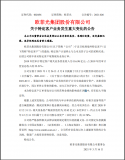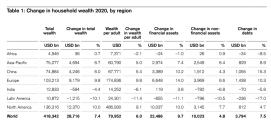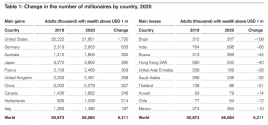Social media influencers help Chinese brands outfox foreign rivals
Financial Times London
Homegrown groups threaten likes of Coca-Cola and L’Oréal with savvy marketing and supply chain prowess
For western companies such as Coca-Cola, Maybelline and Nestlé, century-old brands have long offered a formidable advantage over local rivals in China.
But these established groups are increasingly being threatened by Chinese start-ups whose growth has been turbocharged by savvy social media marketing and optimised supply chains.
That shift was underscored during this month’s “618” ecommerce festival, China’s second-biggest annual shopping event, as local brand Babycare outpaced Procter & Gamble’s Pampers in terms of sales volumes, according to data released by internet group Alibaba.
It wasn’t a one-off: Genki Forest, a Chinese beverage company, overtook Coca-Cola and Pepsi in online sales during last year’s “Singles’ Day”, a multibillion-dollar extravaganza that is the country’s biggest shopping holiday.
A year earlier, Perfect Diary, a homegrown cosmetics brand, leapfrogged Maybelline and Estée Lauder to become number one on Singles’ Day, while in 2019, snack brand Three Squirrels overtook Nestlé.
“Foreign brands used to have an edge in the China market by representing a superior western lifestyle. But Chinese consumers are now more confident in ‘China style’,” said Albus Yu, investment manager at China Growth Capital, a venture-capital fund that has backed brands such as Maia Active, a Chinese challenger to Lululemon.
The pre-eminence of Chinese brands marks a turnround in a country where foreign products have historically been viewed as safer and of higher quality. It also poses a big challenge for multinationals that are increasingly looking to China for growth.
It also chimes with China’s political priorities. President Xi Jinping has urged the country to focus on domestic demand for growth.
“This next decade is going to be the decade of Chinese brands,” said Elijah Whaley, vice-president of Asia-Pacific marketing at Launchmetrics, an analytics company. “The domestic brands will take a large share of China’s growing consumer market.”
In the first three quarters of 2020, domestic sales for Chinese fast-moving consumer goods brands increased 2 per cent while those of foreign brands shrank 6 per cent year-on-year, according to a report by Kantar Worldpanel and Bain.
Much of the recent success of local brands comes down to hefty investments in marketing, particularly on social media, analysts said. That has been fuelled by strong backing from venture capital.
“Marketing has made Chinese products want to grow slowly, and that’s how it works in other markets. But here everything is accelerated because there’s so much venture capital involved,” said Jenny Chen, co-founder of WalkTheChat, a cross-border marketing software agency.
Chinese brands have also been nimble in terms of developing their supply chains. Being close to manufacturing clusters in China, they have cultivated relationships with suppliers, allowing them to accelerate development of new products and trim costs. Often, these suppliers are the same ones through which premium foreign brands source goods.
“The magic is in the small-batch ordering. You can produce thousands of items and see what sticks,” said Rui Ma, China tech analyst at TechBuzz.
Shanghai Chicmax, a cosmetics brand, went from designing to selling a face mask in three days. That process took a foreign shampoo brand three years, Skinny China’s Tanner pointed out.
Variety and speed matter because young Chinese consumers have eclectic tastes and a keener desire to chase trends than their western counterparts, analysts said. While GlaxoSmithKline had 400 products for European customers in one oral care category, it had 12,000 for China, Tanner added.
Young Chinese consumers also expect a sophisticated ecommerce experience. When buying a lipstick, they might first watch an influencer promote it on Douyin, China’s version of TikTok, and then switch to social media platform Xiaohongshu for reviews from professional beauty bloggers before finally buying it on Alibaba’s Taobao after consulting customer feedback and photos.
Some Chinese influencers have amassed huge fanbases, such as “Lipstick King” Li Jiaqi, who has 45m Douyin followers. An endorsement from Li can lead a product to sell out in minutes and he has previously criticised foreign brands such as Hermès and Chanel.
It was watching Li’s livestreams that Zhang Qiping, a 28-year old professional at a foreign company in China, discovered domestic brands Florasis and Perfect Diary.
“I thought the lipsticks looked great, and then I went on Xiaohongshu and found there were lots of people recommending them so I went ahead and bought them,” said Zhang, who had previously bought lipsticks from Dior and Yves Saint Laurent.
But “micro-influencers”, who have a much smaller reach of fewer than 10,000 followers, are also an important group for brand marketing. They are often regular customers who companies have converted into brand advocates, giving them free products or small payments.
“In China’s influencer industry, you can find a price for almost everything: a sponsored campaign that looks like it’s native content or a tiny post by a micro-influencer,” said WalkTheChat’s Chen.
Another effective way for brands to reach customers in China is via groups on messaging platforms such as Tencent’s WeChat, where they are limited to 500 users. This allows brands to interact with consumers in a more intimate environment, but some western companies see them as offering an uncertain return on investment.
When asked for an interview via WeChat, Abby replied that a dedicated member of staff would respond and sent a picture of the cartoon mouse Jerry holding a flower.
Asked how international brands could win her back, Zhang, the consumer working for a foreign company, replied: “When it comes to switching brands, I usually look at reviews on Douyin and Xiaohongshu. It all depends on whether the brands can get beauty bloggers to promote them.”
Financial Times London
Homegrown groups threaten likes of Coca-Cola and L’Oréal with savvy marketing and supply chain prowess
For western companies such as Coca-Cola, Maybelline and Nestlé, century-old brands have long offered a formidable advantage over local rivals in China.
But these established groups are increasingly being threatened by Chinese start-ups whose growth has been turbocharged by savvy social media marketing and optimised supply chains.
That shift was underscored during this month’s “618” ecommerce festival, China’s second-biggest annual shopping event, as local brand Babycare outpaced Procter & Gamble’s Pampers in terms of sales volumes, according to data released by internet group Alibaba.
It wasn’t a one-off: Genki Forest, a Chinese beverage company, overtook Coca-Cola and Pepsi in online sales during last year’s “Singles’ Day”, a multibillion-dollar extravaganza that is the country’s biggest shopping holiday.
A year earlier, Perfect Diary, a homegrown cosmetics brand, leapfrogged Maybelline and Estée Lauder to become number one on Singles’ Day, while in 2019, snack brand Three Squirrels overtook Nestlé.
“Foreign brands used to have an edge in the China market by representing a superior western lifestyle. But Chinese consumers are now more confident in ‘China style’,” said Albus Yu, investment manager at China Growth Capital, a venture-capital fund that has backed brands such as Maia Active, a Chinese challenger to Lululemon.
The pre-eminence of Chinese brands marks a turnround in a country where foreign products have historically been viewed as safer and of higher quality. It also poses a big challenge for multinationals that are increasingly looking to China for growth.
It also chimes with China’s political priorities. President Xi Jinping has urged the country to focus on domestic demand for growth.
“This next decade is going to be the decade of Chinese brands,” said Elijah Whaley, vice-president of Asia-Pacific marketing at Launchmetrics, an analytics company. “The domestic brands will take a large share of China’s growing consumer market.”
In the first three quarters of 2020, domestic sales for Chinese fast-moving consumer goods brands increased 2 per cent while those of foreign brands shrank 6 per cent year-on-year, according to a report by Kantar Worldpanel and Bain.
Much of the recent success of local brands comes down to hefty investments in marketing, particularly on social media, analysts said. That has been fuelled by strong backing from venture capital.
“Marketing has made Chinese products want to grow slowly, and that’s how it works in other markets. But here everything is accelerated because there’s so much venture capital involved,” said Jenny Chen, co-founder of WalkTheChat, a cross-border marketing software agency.
Chinese brands have also been nimble in terms of developing their supply chains. Being close to manufacturing clusters in China, they have cultivated relationships with suppliers, allowing them to accelerate development of new products and trim costs. Often, these suppliers are the same ones through which premium foreign brands source goods.
“The magic is in the small-batch ordering. You can produce thousands of items and see what sticks,” said Rui Ma, China tech analyst at TechBuzz.
Shanghai Chicmax, a cosmetics brand, went from designing to selling a face mask in three days. That process took a foreign shampoo brand three years, Skinny China’s Tanner pointed out.
Variety and speed matter because young Chinese consumers have eclectic tastes and a keener desire to chase trends than their western counterparts, analysts said. While GlaxoSmithKline had 400 products for European customers in one oral care category, it had 12,000 for China, Tanner added.
Young Chinese consumers also expect a sophisticated ecommerce experience. When buying a lipstick, they might first watch an influencer promote it on Douyin, China’s version of TikTok, and then switch to social media platform Xiaohongshu for reviews from professional beauty bloggers before finally buying it on Alibaba’s Taobao after consulting customer feedback and photos.
Some Chinese influencers have amassed huge fanbases, such as “Lipstick King” Li Jiaqi, who has 45m Douyin followers. An endorsement from Li can lead a product to sell out in minutes and he has previously criticised foreign brands such as Hermès and Chanel.
It was watching Li’s livestreams that Zhang Qiping, a 28-year old professional at a foreign company in China, discovered domestic brands Florasis and Perfect Diary.
“I thought the lipsticks looked great, and then I went on Xiaohongshu and found there were lots of people recommending them so I went ahead and bought them,” said Zhang, who had previously bought lipsticks from Dior and Yves Saint Laurent.
But “micro-influencers”, who have a much smaller reach of fewer than 10,000 followers, are also an important group for brand marketing. They are often regular customers who companies have converted into brand advocates, giving them free products or small payments.
“In China’s influencer industry, you can find a price for almost everything: a sponsored campaign that looks like it’s native content or a tiny post by a micro-influencer,” said WalkTheChat’s Chen.
Another effective way for brands to reach customers in China is via groups on messaging platforms such as Tencent’s WeChat, where they are limited to 500 users. This allows brands to interact with consumers in a more intimate environment, but some western companies see them as offering an uncertain return on investment.
When asked for an interview via WeChat, Abby replied that a dedicated member of staff would respond and sent a picture of the cartoon mouse Jerry holding a flower.
Asked how international brands could win her back, Zhang, the consumer working for a foreign company, replied: “When it comes to switching brands, I usually look at reviews on Douyin and Xiaohongshu. It all depends on whether the brands can get beauty bloggers to promote them.”



